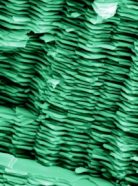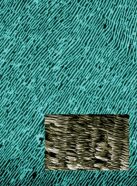Mother-of-Pearl on Ice
Scientists have found a way to copy the mother-of-pearl structures that oysters make.
By Emily Sohn
Pearls are some of the more beautiful examples of nature’s strength. The gemstones grow inside oysters, and they are remarkably sturdy and tough.
Now, scientists have found a way to copy what oysters have been doing all along. They’ve made a pearl-like material that could some day be useful for replacing weak bones and making machines. What’s more, the method promises to be easy, cheap, and kind to the environment.
 |
|
Oysters have a strong layer of armor called nacre (or mother-of-pearl). The substance is made up of tiny crystals pieced together like the bricks and mortar of a brick wall, as seen in this micrograph.
|
| © Science |
Oysters, abalone, and some other mollusks have a strong layer of armor called nacre (or mother-of-pearl). The substance is made out of tiny crystals and proteins, pieced together like the bricks and mortar of a brick wall.
Their structure makes these natural materials sturdier than any human-made ceramics (a category that includes clay, cement, and glass). Scientists have long tried to mimic the architecture of these creatures’ shells, with little success.
Researchers at the Lawrence Berkeley National Laboratory came up with a new approach. First, they mixed water with a ceramic powder and some glue-like molecules, called polymer binders. Then, they poured the concoction into a little chamber that measured a few centimeters across.
The scientists carefully controlled chilly temperatures at the top and bottom of the chamber, until an icy structure formed. The ice was similar to the ice that sometimes forms in frozen seawater.
 |
|
New materials made from microplates of ceramic such as alumina joined by metal mortar have a layered structure like that of natural mother-of-pearl (inset). The two micrographs are at different scales. The artificial plates are actually about 10 times as thick as those in the mother-of-pearl. |
| © Science |
A closer look at the ice structure showed that it contained vertical sheets made of tiny, hexagonal (six-sided) ice crystals. As those crystals grew, the ceramic powder and polymers gathered between the ice sheets.
The scientists put this entire structure through freeze-drying to remove the ice. Heating the material to high temperatures then fused the remaining powder and polymers into solid sheets. Finally, they added a filling between the ceramic sheets to act like the protein mortar that’s found in nacre.
One potential application of the technique is to make a strong framework for growing new human bones to replace ones that are broken or weak from disease. Tough, pearl-like mixtures of aluminum, silicon, and titanium, on the other hand, could be useful for engineers who construct machines and work with electronics.
Glamorous pearl necklaces will probably never go out of style. Now, however, they hint at a suite of new technologies to come.—E. Sohn
Going Deeper:
Weiss, Peter. 2006. Mother-of-pearl on ice: New ceramics might serve in bones and machines. Science News 169(Jan. 28):51-52. Available at http://www.sciencenews.org/articles/20060128/fob2.asp .
You can learn more about mother-of-pearl (or nacre) at en.wikipedia.org/wiki/Mother_of_pearl (Wikipedia).
Sohn, Emily. 2004. Inspired by nature. Science News for Kids (Nov. 3). Available at http://www.sciencenewsforkids.org/articles/20041103/Feature1.asp .







